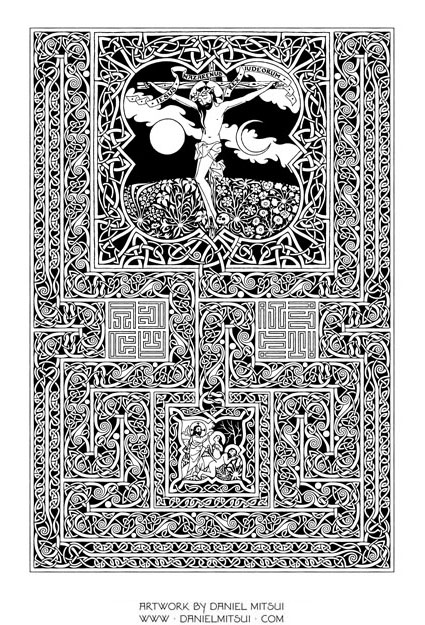
Christian Labyrinths: A Celtic Coloring Book was published by Ave Maria Press in 2017. It measures 9" × 12" and contains thirty coloring pages. Some of these display labyrinths that connect different scenes from the Old and New Testaments; others spell out the Pater Noster in stylized block letters; others imitate the cruciform carpet pages in early medieval manuscripts. There are two different puzzle challenges in the book: that of finding a single deliberate mistake in the ornament on each page; and that of deciphering a coded message at the end.
You can order this book from Ave Maria Press here: Christian Labyrinths by Daniel Mitsui
Or through Amazon here: Christian Labyrinths by Daniel Mitsui
This is my introduction to the book:
One of the most distinctive and beautiful styles of Christian art flourished in Irish and Northumbrian monasteries from the sixth to the ninth centuries. The style is usually called Celtic, although some of its finest examples were made by Saxons. It is notable especially for its intricate, labyrinthine patterns of knots, spirals, keys and animals.
Its greatest masterpieces are sacred manuscripts, such as the Lindisfarne Gospels and the Book of Kells. Although this style of art fell into disuse, the surviving manuscripts continued to be held in the highest esteem. In 1185, Gerald of Wales wrote: You will make out intricacies so subtle and delicate, so exact and compact, so full of knots and links, with colors so fresh and vivid, that you might say that all this was the work of an angel, and not of a man.
Today, Celtic knots remain popular decorations, although they are more commonly encountered on knickknacks than in churches. I want to reconnect this style to the purpose that occasioned its greatest works: not to decorate bits of paddywhackery, but to honor the Holy Gospel.
A different tradition of Christian art places labyrinths on the floors of churches, usually at a large enough scale that their paths can be walked. This kind of labyrinth was inherited from Classical culture and given new use and meaning by the early Christians. In some churches, the labyrinth is a symbol of escape from the spiritual death of sin; in others, the center represents a destination of pilgrimage, such as Jerusalem. The most famous examples are in the Gothic cathedrals at Chartres, Reims and Amiens.
In recent years, there has been a revival of labyrinth-walking, whose promoters are influenced by New Age spirituality. This has made some Christians leery of labyrinths altogether. My belief is that labyrinths are well-established within the artistic tradition of orthodox Christianty, and beneficial so long as they are not taken out of their rightful context and assigned some dubious mystical meaning in themselves.
My intention is to restore Christian labyrinths to their rightful context: biblical, patristic and liturgical, the same that they had in illuminated manuscripts and in Gothic cathedrals. I hope to demonstrate that the beauty, the mystery and indeed the fun of these things properly belong to orthodox Christianity.
In this book, I have taken inspiration from both the manuscript and architectural traditions. All of the illustrations and ornamental elements I designed myself, first drawing them by hand in ink on calksin or paper.
DM
